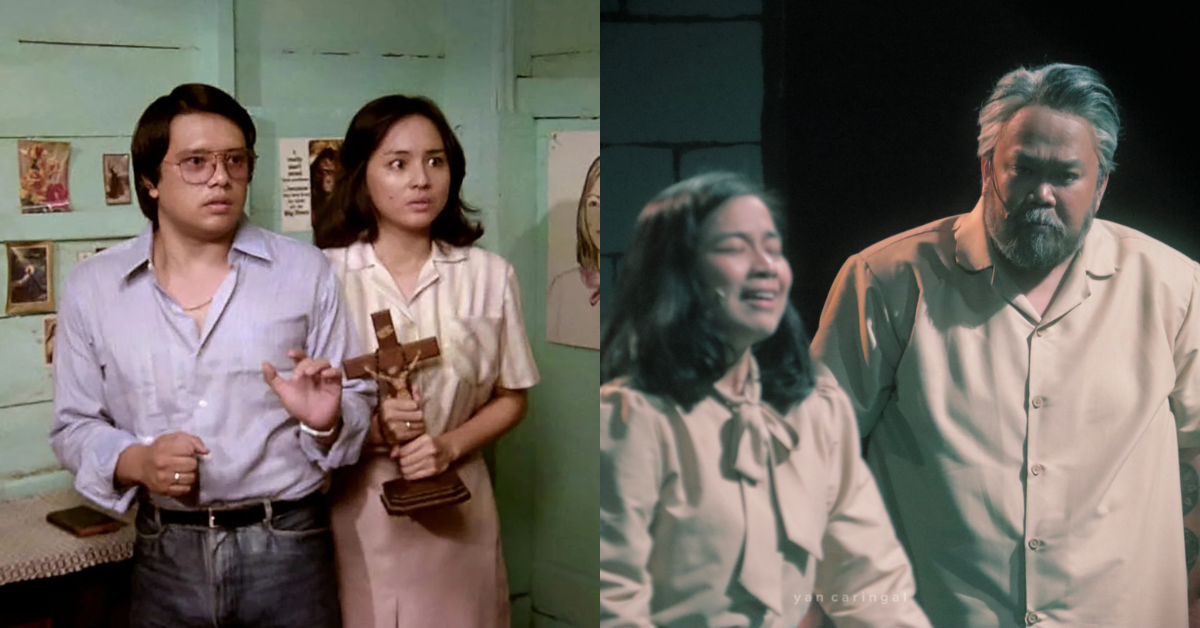
Photos / Kisapmata and Yan Caringal
There is a lot of pressure on Kisapmata, Tanghalang Pilipino’s stage adaptation of the Mike de Leon film based on the Nick Joaquin short story “The House on Zapote Street,” included in Reportage on Crime. After all, the film is considered one of the best works in Philippine cinematic history. Joaquin, meanwhile, is a National Artist for Literature regarded by many as the most distinguished Filipino writer in English. Despite being the third iteration of the same story, Kisapmata, the play, stands on its own and brings something new to the stage.
The story remains the same, of course. Across all three versions, Dadong, a controlling patriarch, opposes his daughter Mila’s marriage and her attempts to escape from their household.
The stage adaptation still presents the feeling of suffocation, menace, and dread that made both the report and the film enduring classics. But Guelan Luarca, who wrote and directed the play, demonstrates the meaning of “adaptation”: He took elements from the reportage and the film and added a fresh perspective.

Photo / Yan Caringal
Perhaps the most notable change is that all the characters are now active participants in the story. In the story and film, Dadong’s wife Dely, Mila, and her husband Noel, seem to play passive roles in the patriarch’s tyranny. The stage adaptation fully fleshes them out by giving them more agency, thus giving them more colorful (if bleaker) inner lives.
Luarca also updates the character of Dadong. Vic Silayan portrayed the role as a looming and intimidating presence in the film, but the on-stage Dadong is friendly, even charming. Not everything is as it seems, and this charisma is only a mask for something sinister.
Dadong can easily be compared to people in power, who, as the dramaturg says in their notes, “weaponizes charm and laughter to normalize death and project his power.” It’s easy to see Kisapmata as an allegory for the country’s political landscape, and the stage adaptation amplifies this.

Photo / Yan Caringal
Luarca found the perfect Dadong in Jonathan Tadioan, who seems to have been born for this role. Tadioan has a large presence that he effortlessly manipulates: He knows how to switch from affable tatay to frightening strongman and back to the chummy father figure. The writer can still hear Dadong’s laugh, which alternates between endearing and terrifying.
Dely, Mila, and Noel may stand under Dadong’s shadow, but the cast matches Tadioan’s charisma and presence on stage. Lhorvie Nuevo-Tadioan is spectacular as Dely. Like Charito Solis in the film, Nuevo-Tadioan doesn’t need to speak to convey her emotions. And when she does, she commands the stage. The use of spotlights was just *chef’s kiss*.
Mila and Noel are originally portrayed as meek, even limp-wristed. This portrayal has the danger of being one-note, but Toni Go-Yadao and Marco Viaña surprise you with peaks and valleys in their performances. Luarca made the characters more complex, and both actors elevated their roles on stage. Kisapmata is truly an ensemble cast: everyone was wonderful.

Photo / Yan Caringal
Tanghalang Pilipino’s production honors the source material’s pervading feeling of claustrophobia. The production breathes new life into it with Luarca’s script and direction and the cast’s exceptional performance. Kisapmata is terrifying, but it’s a must-watch.
Tanghalang Pilipino’s Kisapmata will be staged from March 7 to 30, 2025, at the Tanghalang Ignacio Jimenez at the Cultural Center of the Philippines Complex in Pasay City. The play features the TP Actors Company, with Arjay Babon, Sofia Sacaguing, Sarah Monay, and Mark Lorenz playing the understudies.
Rafael Jimenez and Kat Batara provide assistant direction, while JM Cabling controls movement direction. Joey Mendoza provides set design, Bonsai Cielo for costume design, and Arvy Dimaculangan for music and sound design. D Cortezano provides lighting design and technical direction, and Missy Maramara gives intimacy direction.
The play is rated R-16. This means that “only viewers who are 16 years old and above can be admitted. An ‘R-16’ classification advises viewers, parents, and supervising adults that the film may contain any of the elements that may not be suitable for children below 16 years of age, such as sex, horror, crime, cruelty, violence, offensive language, and self-harm.”
Tickets are available via Ticket2Me and TicketWorld.
What do you think? Share your thoughts below!
Do you have a story for the WhenInManila.com Team? Email us at story.wheninmanila@gmail.com or send us a direct message at WhenInManila.com Facebook Page. Interact with the team and join the WhenInManila.com Community at WIM Squad. Join our Viber group to be updated with the latest news!






